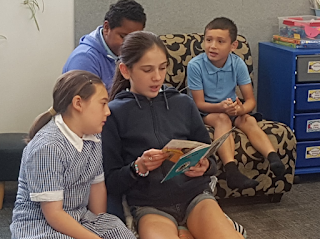New Levels in Literacy
At the beginning of the year, the team in Takitini reflected on how we have organised and implemented out Literacy programme in the past and discussed options for teaching and learning for 2020.
We thought it would be better to have each teacher responsible for certain levels. Last year we each had a range of levels but it was sometimes a struggle trying to teach in a short amount of time and cater to all needs, especially with those that were quite needy.
We decided that I would take the lower end groups. That felt extremely daunting to me.
In the past, I have usually taken the groups who were the more capable readers. The groups I have this year range from Magenta to Turquoise.
I felt inexperienced with taking so many students who were all at these levels. I felt like I needed to do a bit of upskilling and have a very clear idea of what I would do in Literacy classes and what we would cover.
I spent some time talking with junior school staff and did some online research in regards to teaching reading and writing in the junior levels of school. I spent the first couple of sessions trying to get an idea of where each child was at and getting to know them as the majority are new to our hub.
After trying to become better informed and working with teacher aides to develop learning support needs, I quickly started to feel more confident and capable of teaching at this level.
I can see progress in all of the students and have managed to include a range of learning areas within the programme. The preparation time quite a lot but the benefits of having their resources and activities ready and consistent makes a huge difference for the children.
Here are a few photos from some of our Literacy activities in term one:
 |
| Connor does some matching activities. |
 |
| Students work near a word bank we co-created to support writing from picture prompts. |
 |
| Developing work habits and focus has been a priority for many students. |
 |
| Working on letter formation. |
 |
| Sharing our learning...and happy about it. |
 |
| Developing fine motor skills and letter formation. |
 |
| Writing from picture prompts that we have a group discussion about prior to writing. |
 |
| Buddy reading with students from another Literacy group. |
 |
| Buddy reading to increase reading mileage. |
 |
| Quite high engagement during buddy reading. |
 |
| Support from other learners. |
 |
| I created a Wall of Words to support students with recognising high-frequency words. Essential word cards and visual writing prompts that the junior school use. This was started during our professional learning with Murray Gadd. |
 |
| Our Literacy corner. Includes: Reading activities, fine motor skills, handwriting, writing word bank, writing sheets, visual prompt strips, word families, phonics cards, reading book boxes and sight words sheets. |
My next step is to continue to refine my programme and give it some time to develop. I also want to observe in the junior school, Reading Recovery and teacher aides taking precision teaching.
• Be informed by research and innovations related to: content disciplines; pedagogy; teaching for diverse learners, including learners with disabilities and learning support needs; and wider education matters.
• Select teaching approaches, resources, and learning and assessment activities based on a thorough knowledge of curriculum content, pedagogy, progressions in learning and the learners.








































